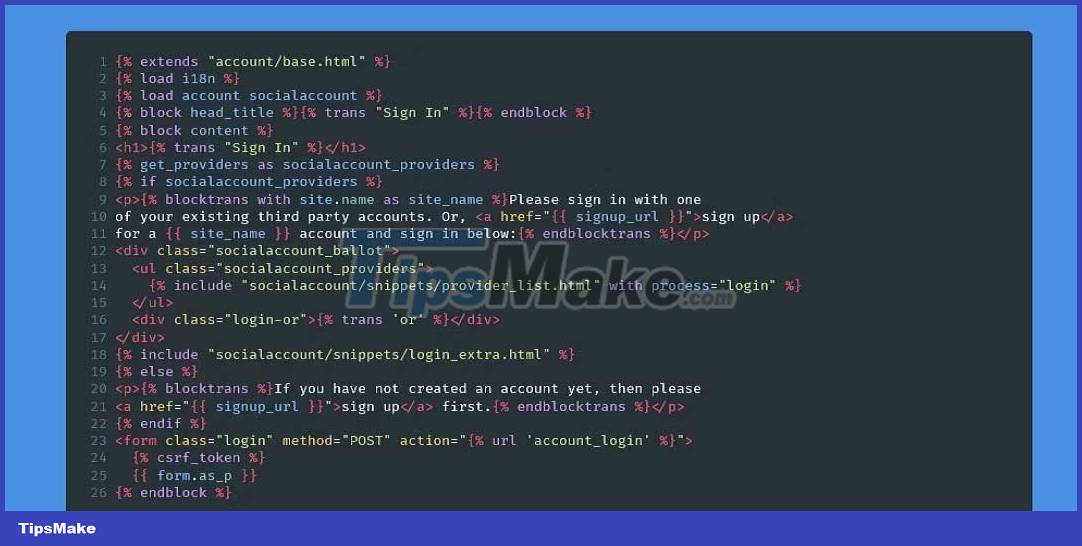How to override default template in django-allauth
django-allauth is a Django package that allows you to build authentication systems for applications quickly and easily. It has many templates available for you to focus on the important parts of the app.
Although the existing templates are useful, you will want to change them when you cannot choose the best UI.
How to install and configure django-allauth
By following a few simple steps, you can instantly install django-allauth into your Django project.
1. You can install the django-allauth package using the Pip package manager:
pip install django-allauth2. In the project settings file, add these apps to the installed applications:
INSTALLED_APPS = [ """ Thêm ứng dụng khác vào đây """ # Các app cấu hình Djang-allauth 'django.contrib.sites', 'allauth', 'allauth.account', 'allauth.socialaccount', # add this if you want to enable social authentication ]
3. Add authentication backend to the installation file:
AUTHENTICATION_BACKENDS = [ 'django.contrib.auth.backends.ModelBackend', 'allauth.account.auth_backends.AuthenticationBackend', ]4. Add a site ID to the project:
SITE_ID = 15. URL configuration for django-allauth:
from django.urls import path, include urlpatterns = [ # Djang-allauth url pattern path('accounts/', include('allauth.urls')), ]If configured correctly, you should see a pattern like this when you navigate to http://127.0.0.1:8000/accounts/signup/ :

You can see the list of available URLs by navigating to http://127.0.0.1:8000/accounts/ with DEBUG=True in the installation file:

How to override login form in django-allauth
First, you need to configure the templates directory if you haven't done so already. Open the installation file and navigate to the TEMPLATES listing . Inside it, locate the DIRS list , and edit it as follows:
'DIRS': [BASE_DIR/'templates'],Make sure you have a templates folder in the root of your project. You can override the default login form in django-allauth by following the steps below.
Step 1: Create sample file
In the templates folder , create a new folder named account to contain templates related to django-allauth.
The registration and login forms will be signup.html and login.html respectively . You can determine the exact template name by opening the Python virtual environment and navigating to the Lib folder > site-packages > allauth > templates > account to find the template. Let's look at this code to understand how templates work. For example, the login form has this code inside it:

Step 2: Add HTML code to the template file
After creating the file, you will add custom HTML code to the template. For example, to override the above login form, you might want to copy everything from the {% else %} block , containing the form & submit button, and add it to the custom form. For example:
{% extends 'base.html' %} {% block content %}If you have not created an account yet, then please sign up first.
{% csrf_token %} {{ form.as_p }} {% if redirect_field_value %} {% endif %} Forgot password? {% endblock content %}The above code uses Django's template inheritance to inherit base.html template features. Make sure you remove redundant tags like {% blocktrans %}. If you've completed it, the login page will look like this:

Step 3: Add custom styles to the form
In the previous step, the login form was shown as a paragraph with the tag {{ form.as_p }}. To add style to the form, you need to know the value of the name attribute associated with each input field.
You can check the page to get the value you need.

The image above shows the name attribute combined with the form's email field.
Now you can add each form field to the project. For example, you can add an email field like this:
{{ form.login }} {{ form.login.errors|safe }}You can use Bootstrap with your Django project to easily style your forms. Here is an example:
{{ form.login }} {{ form.login.errors|safe }} The code above adds the Bootstrap form class to this form. Now you can add any other fields you need and style them as desired. The example below uses Bootstrap for styling:
Sign in
{{ form.non_field_errors | safe }} {% csrf_token %} {{ form.login }} {{ form.login.errors|safe }} {{ form.password }} {{ form.password.errors|safe }} {{ form.remember }} {% if redirect_field_value %} {% endif %} Forgot Password?
The above code block will produce results similar to the following image:

django-allauth contains many default templates that you can override. With the above instructions, you can override any template in django-allauth . You should consider using this package to handle the authentication system, so you can focus on building other important features for the application.
You should read it
- How to build an authentication system in Django using OAuth
- How to use AWS S3 Bucket to store static and media files in Django
- Using Django API is easy with built-in templates
- How to Add Search to a Django App
- How to upload photos using Django app
- How to Create a CRUD App with Django's Class Based Viewers
- How to Implement ChatGPT in Django
- Should Django be hosted on PythonAnywhere?
May be interested
- Should Django be hosted on PythonAnywhere?
 pythonanywhere is suitable for django development but is it easy to set up? let's find out together!
pythonanywhere is suitable for django development but is it easy to set up? let's find out together! - Top 5 Sites to Download Free OneNote Templates
 whether you need a comprehensive project management template, a visually appealing meeting agenda, or a beautifully designed collection of recipes, there's a template to suit your needs.
whether you need a comprehensive project management template, a visually appealing meeting agenda, or a beautifully designed collection of recipes, there's a template to suit your needs. - 10 awesome PowerPoint templates make the presentation 'shine'
 in today's article, tipsmake.com will introduce 10 best powerpoint templates, saving you time and effort when creating presentations.
in today's article, tipsmake.com will introduce 10 best powerpoint templates, saving you time and effort when creating presentations. - Template in C ++
 the template is the foundation of generic programming, ie code according to which is independent of any specific type.
the template is the foundation of generic programming, ie code according to which is independent of any specific type. - The best free Microsoft Word template download websites
 when you need to compose a document in microsoft word, using the template is helpful. whether you want to create a resume, a report, a proposal, a plan, or another popular document, templates will give you a starting point in the right format.
when you need to compose a document in microsoft word, using the template is helpful. whether you want to create a resume, a report, a proposal, a plan, or another popular document, templates will give you a starting point in the right format. - Lesson 25: Use the Template
 templates are pre-designed documents that you can use to create new documents of the same format. with templates, many decisions to design important documents, such as margin size, font style, font size and predefined line spacing.
templates are pre-designed documents that you can use to create new documents of the same format. with templates, many decisions to design important documents, such as margin size, font style, font size and predefined line spacing. - How to create a movie ticket booking system using Django
 programming a movie ticket booking system using django is not difficult. below is a detailed step-by-step guide on how to book movie tickets using django.
programming a movie ticket booking system using django is not difficult. below is a detailed step-by-step guide on how to book movie tickets using django. - MS PowerPoint - Lesson 7: PowerPoint design template
 you can create your own powerpoint design template. starting with a white design, add elements such as the slide background, color scheme, size and style, size and position of each content accordingly ... then, record the file as a powerpoint template (powerpoint template).
you can create your own powerpoint design template. starting with a white design, add elements such as the slide background, color scheme, size and style, size and position of each content accordingly ... then, record the file as a powerpoint template (powerpoint template). - Invite download Profile template Curriculum vitae, job application, ... extremely professional from Microsoft
 here are links to download primer templates for resume, application, leaflets, business cards ... professionally supported by microsoft office word. in particular, in addition to english these templates have vietnamese support.
here are links to download primer templates for resume, application, leaflets, business cards ... professionally supported by microsoft office word. in particular, in addition to english these templates have vietnamese support. - Top gorgeous Word cover templates for books, reports, lesson plans
 if you want to add something to a report or essay, an attractive cover will help you attract attention. book covers, reports, lesson plans not only bring sophistication to your documents, but also introduce people to the title, author, date and brief summary.
if you want to add something to a report or essay, an attractive cover will help you attract attention. book covers, reports, lesson plans not only bring sophistication to your documents, but also introduce people to the title, author, date and brief summary.










 How to manage packages in openSUSE with Zypper
How to manage packages in openSUSE with Zypper How to Install Apache Guacamole via Docker on Ubuntu 22.04
How to Install Apache Guacamole via Docker on Ubuntu 22.04 How to install and use AnyDesk on Linux
How to install and use AnyDesk on Linux How to create and delete folders in Linux Terminal
How to create and delete folders in Linux Terminal How to install and use GNU nano to edit files on Linux
How to install and use GNU nano to edit files on Linux How to Install and Use Homebrew on Linux
How to Install and Use Homebrew on Linux